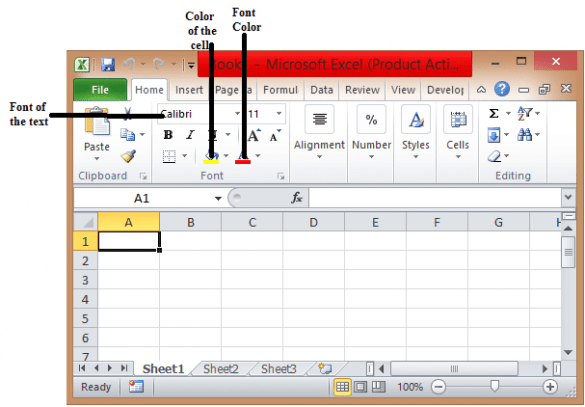Create Excel Templates Quickly: Step-by-Step Guide

Creating Excel templates is an incredibly useful skill for anyone looking to streamline their data analysis, reporting, or administrative tasks. With Microsoft Excel's robust features, you can design templates that are not only functional but also aesthetically pleasing. This guide will walk you through the process of creating Excel templates quickly, ensuring you maximize productivity while maintaining data integrity.
The Importance of Excel Templates

Excel templates are essential for:
- Consistency: Templates ensure data is consistently formatted, reducing errors.
- Efficiency: Save time by not having to set up data structures and formats each time.
- Customization: Tailor your workbook to specific needs, making data entry and analysis quicker.
Setting Up Your Excel Workbook

Before diving into template creation, it's worth considering what your template needs to achieve. Here are some initial steps:
🔍 Note: A well-planned template structure is the foundation for effective data management.
1. Define the Purpose

- Identify the primary use case for your template. Is it for inventory management, financial reporting, or a different purpose?
- Determine the key features needed, like dropdown lists, data validation, or specific formulas.
2. Choose the Right Excel Version

- Use a recent version of Excel for access to advanced features like Power Query or Power Pivot.
3. Start with a Blank Workbook

- Open Excel and select “Blank Workbook”.
- Use File > Save As, choose ‘Excel Template (*.xltx)’, and name your template accordingly.
Designing Your Template


Now, with your workbook prepared, let’s explore how to design an effective Excel template:
1. Setting Up the Data Structure

- Plan your rows and columns for data entry.
- Use the ‘Table’ feature for dynamic data ranges and automatic formula updates.
📝 Note: 'Tables' in Excel can significantly simplify data management by automatically extending formulas when new rows are added.
2. Formatting for Readability

- Select a clean, professional theme.
- Apply conditional formatting for visual cues.
- Use cell borders and background colors to differentiate sections.
3. Implementing Data Validation

- Use data validation rules to restrict what data can be entered in certain cells.
- Create drop-down lists to control input options.
4. Formula and Functions

- Embed formulas to automate calculations.
- Consider using named ranges for easier formula management.
5. Protecting Your Template

- Protect sheets or specific cells to prevent unauthorized changes.
Adding Advanced Features

After setting up the basic structure, consider integrating advanced features:
1. Pivot Tables

- Include an area for pivot tables to allow for dynamic data analysis.
- Preconfigure pivot tables if the data structure is consistent.
2. VBA Macros

- Automate repetitive tasks or add custom functionality with Visual Basic for Applications (VBA).
3. Charting and Dashboards
- Incorporate charts or dashboards for visual data representation.
- Use dynamic data sources to ensure charts update with new data.
4. Power Query
- If your template involves regular data import from other sources, set up Power Query to automate this process.
Testing and Finalizing

Before distributing your Excel template, ensure it is robust:
1. Data Entry Simulation
- Simulate real-world data entry to check for errors, inconsistencies, or missing validations.
2. Feedback Gathering
- Get feedback from potential users to refine the template further.
3. Documentation
- Include instructions or a user guide within the template to help users understand its functionality.
After testing and refining your Excel template, you are ready to distribute it. Remember that even the best templates will need occasional updates as business needs evolve, so consider including a version control section.
In this guide, we have covered the entire process of creating Excel templates from planning to testing. By following these steps, you can create templates that not only streamline your work but also provide a solid foundation for data consistency and quality. Utilize these techniques to produce reliable, efficient, and user-friendly Excel templates that will enhance your data management and analysis processes.
What is the difference between a workbook and a template in Excel?
+A workbook in Excel is a blank document where you perform your data analysis or entries. A template, however, is a pre-designed workbook with formatting, formulas, and sometimes data entry restrictions already set up. Templates are used to ensure consistency and efficiency in repetitive tasks.
Can I protect specific parts of an Excel template to prevent users from changing critical data?
+Yes, Excel allows you to protect individual cells, ranges, or entire sheets with passwords or to allow editing only by certain users. This can prevent unauthorized changes to formulas, formatting, or critical data.
How do I update an Excel template if the requirements change?
+To update a template, open it and make the necessary changes. Save the template back as an .xltx file. Remember to communicate changes to all users of the template to ensure everyone is using the updated version.
Are Excel templates compatible with older versions of Excel?
+While templates can be saved to work with older versions of Excel, some newer features might not be supported. It’s always best to check compatibility or save the template in a format compatible with the oldest version of Excel you expect users to have.
How can I ensure my Excel template looks the same on different computers?
+Use embedded fonts or fonts that are likely to be available on all systems, avoid using system-specific settings, and save the template with the ‘Embed fonts in file’ option enabled to maintain font consistency. However, differences in screen resolutions, color settings, or operating systems might still affect the visual appearance slightly.



